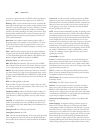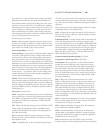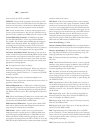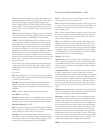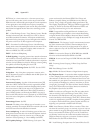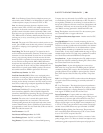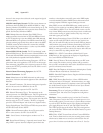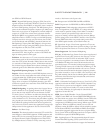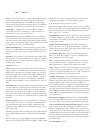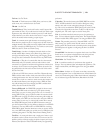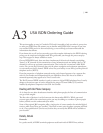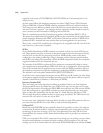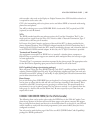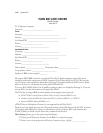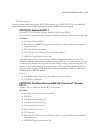112 | Appendix 2
DS0’s). e most common framing scheme for T1 “robs” bits for
signaling leaving 56kbps per channel available for data use.
T-1- An alternative expression for T1. See T1.
TA - Terminal Adaptor. e electronic interface between an ISDN
device and the NT1. e terminal adapter handles the dialing func-
tions and interfaces to the user’s data equipment as well as to the
NT1 on the “S” or “T” interface.
Tandem Switch- A switch which is between two others. It connects
two trunks together. Long distance calls on a LEC line go through
a long distance tandem that passes them through to the long dis-
tance provider’s switch.
Tandem Tie Trunk Switching- When a PBX switch allows a
tie line call to dial out of the switch. For example, if switch “A” in
Arkansas has a tie line to switch “B” in Boise, Boise could use the tie
line to make calls from switch “A”.
TD- Transmit Data. Data coming from the DTE towards the
DCE or network. Also, a light on a modem or CSU/DSU that
lights to indicate presence of this signal.
TEI - Terminal Endpoint Identifier. An OSI Layer 2 identifier
used by an ISDN terminal to communicate with the serving CO.
Most equipment uses a dynamic TEI assignment procedure .
Telco- Telephone Company. Your local telephone service provider.
In the 21st century you generally have a choice of Telcos if you are
a business in a major metropolitan area in the USA. Competition is
coming to the Telecom industry around the world.
Telcordia Technologies- Formerly Bellcore. e research and
development organization owned by the telephone companies.
Telcordia represents the phone companies in developing standards
for Telco equipment and in testing equipment compliance to
those standards. Promotes competition and compatibility through
standards promoting interoperability such as GR-303. Telcordia
also offers educational and training programs open to all interested
parties. Bellcore was sold to SAIC in 1997. Telcordia is responsive
to both RBOCs and independent Telcos. eir web site is: http://
www.telcordia.com.
Telos Customer Support +1 216.241.7225. Generally available
from 9am to 6pm EST, but you can try at other times. You may
also ask for assistance by emailing to support@telos-systems.com
Telos Test Line(Xstream, Zephyr & ZephyrExpress)- 24 Hour
test line which can be called to verify correct operation of your
Zephyr or ZephyrExpress codec. Numbers are +1 216-781-9310
and +1 216-781-9311. e test line transmits in dual/mono mode
at 32KHz and can be received in L3 Mono using one B channel or
L3 Stereo using 2 B channels. Telos also maintains an identically
configured test line in Freising, Germany at 49 81 61 42 061 (dial
this number twice).
Terminal Adapter- See TA
Standards. SS7 does. It allows for substantially flexibility and power
in dynamically routings calls. An SS7 database lookup is how a
call to a mobile telephone user can handled transparently despite
the fact that the user’s location may change. Also used to determine
what carrier should handle a given toll free call. See also CCIS.
Station Line – A telephone circuit from a PBX to a telephone
on that PBX. Since this is a telephone-to-switch connection it is
considered to be a “line”. See Line and Trunk
Station Side - e user side of a PBX. e side of the switch that
the telephones are attached. Also, occasionally called the ‘line side’.
e main reason for distinguishing between this and the trunk side
is that certain customer related features (Such as Hold and Transfer)
are inapplicable to trunks. See also Trunk Side.
Statistical Multiplexing- A method of improving effective band-
width of a Telco channel. Data is divided into packets, which is sent
on the channel when there is space available. is is the key to the
Internet.
Subscriber- e customer of a Telecommunications company. is
term dates back to when a local Telephone Company was formed at
the specific request of a group of customers who agreed in advance
to “subscribe” to the service.
Superframe- See SF
Switch- Telephone switching device which “makes the connection”
when you place a call. Modern switches are specialized computers.
ISDN service is provided from a “Digital” switch, most commonly
(in the USA & Canada) an AT&T model “5ESS”, Northern Tele-
com model “DMS-100”, or Siemens model “EWSD”. e switch,
and related software running on it, will determine which ISDN
protocol(s) will be available to customers connected to it. See also
PBX.
Switched Circuit- A channel which is not permanent in nature, but
is connected through a switching device of some kind. e switch-
ing device allows a switched circuit to access many other switched
circuits (the usual “dial up” type of telephone channels). Once the
connection is made however, the complete capacity of the channel is
available for use. As opposed to a dedicated circuit or a packet based
connection.
Synchronous Data- A form of serial data which uses a clock signal
to synchronize the bit stream. Since, unlike asynchronous data, no
start and stop bits are used, data throughput is higher than with
asynchronous data. ISDN and T-1 use Synchronous data. See also
Asynchronous Data.
T-Link- A proprietary Telos 2.048mbps channelized link. is link
uses the DSX-1 electrical protocol and has 30 channels at 64kbps
each.
T1- A common type of digital telephone carrier widely deployed
within the US, Canada, and Japan. Has 24 64Kbps channels (called



